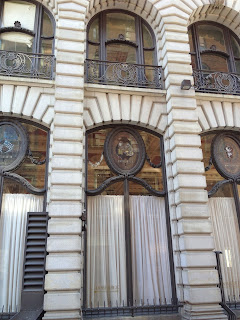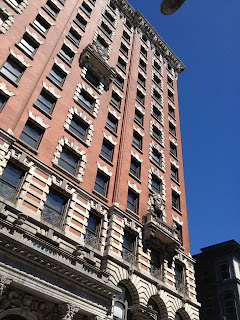 This week's walk took me past The Union Trust Company Building at 60/62 Dorrance Street in Providence. This gorgeous edifice is a 12-story, steel-frame, brick and stone office building constructed in 1901-1902, and at the time it was the tallest in Providence, and possibly the tallest in New England!
This week's walk took me past The Union Trust Company Building at 60/62 Dorrance Street in Providence. This gorgeous edifice is a 12-story, steel-frame, brick and stone office building constructed in 1901-1902, and at the time it was the tallest in Providence, and possibly the tallest in New England!It was built for the Union Trust Company, a bank helmed by Providence financier and industrialist, Marsden Perry, and it was built the same year that Perry bought, refurbished, and moved into the historic John Brown House at 52 Power Street. Stone, Carpenter & Willson, architects, were working on both projects, as well as on a renovation at 2 George Street, where Perry lived prior to moving into the John Brown House. Mr. Perry and his architects must have been very busy with construction details that year! (Not that the bank presidency was all Perry had to keep him busy--he also owned the Narragansett Electric Company and the city's trolley system.)
Banks were expected to be impressive buildings in those days--to instill in customers a feeling of confidence in the wealth and power of the bank and its management. And the Union Trust Company building certainly did that.
 |
| The Union Trust building in 1906. |
The first floor became a restaurant called Federal Reserve in 1996, and has been occupied by The Dorrance restaurant since 2011.
Some of the interesting architectural and interior design features of this building include:
| The Puritan and the Indian. |
- a Corinthian-columned entrance with bas-relief figures of an Indian and a Puritan--carved by Daniel Chester French (who is more famous for the Lincoln Memorial in Washington DC and the Concord Minuteman). French appears to have been sought after by numerous local firms in the early 20th century; see my blog entry on French's beautiful elevator doors at another former bank not far from this one.
- Banks of 20-foot high windows, each with a rosette in stained glass that contains the coat of arms of a major European banking family or center (all the big names of 1901). What reassurance this must have provided to the local bank customers--they could imagine their bank as practically on a first name basis with the Rothschilds, etc.
- A 12-story staircase of green glass. At the time the bank was built, elevators had been invented, but none was able to handle a 12-story rise. The staircase was designed to let light pass through it from a skylight on the roof, and also was supposed to provide entertainment for those poor unfortunates who had to climb to the 12th floor!! Interestingly enough, Perry installed similar (though much smaller) glass staircases
in the renovation of both his current home (2 George Street) and his future home (52 Power Street). (The staircase at the John Brown House is not open to the public--but you can see the base of it in the back of the building, between the long center hallway and the bookstore/gallery space in the back.)
The glass staircase at 2 George St. - The first double-doored bank vault in New England. In the hurricane of 1938, when downtown Providence flooded up to 13 feet deep, and first floors of all the businesses
were flooded, the double-doored vault stayed dry inside (unlike vaults at many other banks, where bank tellers purportedly stayed busy ironing the currency dry after the waters receded).
Sign on the exterior wall at 60-62 Dorrance St.

 Illustration Credits and References
Illustration Credits and ReferencesThe 1906 photo of the Union Trust Company building is from the Detroit Publishing Company Photograph Collection at the Library of Congress.
The photo of the glass staircase at 2 George St. was found on the 2 George Street website.
All other photos by author.
Information on the architecture of the Union Trust Company building from Providence, A Citywide Survey of Historic Resources, by William McKenzie Woodward and Edward F. Sanderson, published by the RI Historical Preservation Commission in 1986.

How very interesting.
ReplyDeletewhere is the water mark sign on the building?
ReplyDeleteNear the Dorrance/Westminster corner at about eye level.
Delete